Singer 152 class
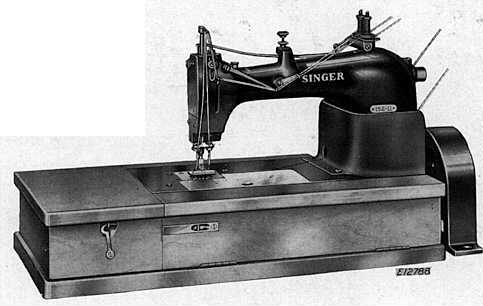
Singer 152-11
Singer Class 152 Machines
There are two known versions of Singer 152- class machine, the 152-1 and the 152-11. These are machines of the 152- class (“152 dash class") and are not to be confused with Singer 152W class machines. 152W machines are lockstitch machines of an entirely different class.
For Facings, Stays, and Centers on Men's
Shirts
They were listed as for stitching facings and button stays and bluff shirt
centers on men's shirts and for general wide gauge double needle, double
chainstitch work in equivalent weight fabrics.
Double Needle. Four Thread Stitch type 401
This is a double needle, four thread machine producing two parallel rows of stitching. Each row of stitching is formed by one needle carrying an upper thread and one looper carrying an under thread, or lower thread. Each row of stitching formed is a Stitch Type 401, also called a 401 chainstitch, and also called a 401 double chainstitch, or more technically known as a "Federal Stitch Type 401".
Uniqueness and Desirability
I currently have a 152- class machine. It’s the only one I’ve ever come across
in person. There may have been a 152-1 machine on eBay in the past, or it may
have been another website. The 152-11 machine I have has a 1" gauge between
lines of stitching. It should be successful with button stays between 1 & 1/8"
up to 1 & 1/2". From my way of thinking, it's ideal for 1 & 1/4" wide stays.
I worked quite often for a factory that had several 147- machines sewing full
time, at full speed. I got to know and appreciate the 147- machines and by
extension the 62- machines as they have many of the same parts (same part
numbers) as far as I have seen.
The 148- machines are feed up the arm 147- class machines and the 152- machines
are wide gauge 147- class machines.
Quality of Stitch
Thankfully, as far as I have seen, Singer, Union Special, Wilcox & Gibbs,
Metropolitan, and all of the USA made, European made, Japanese made, and some
others too, have all been capable of producing a good-looking, well balanced
stitch. I feel that the Singer 147- class based machines produce perhaps the best looking
and best formed 401 chainstitch.
Use of term "Double Chainstitch"
Singer did use the designation 401 style stitch, and called a 401 stitch in most brochures a “double chainstitch”. I’ve never come across Singer using the
designation 401 style stitch for anything other than that same “double
chainstitch”.
Union Special " also used the designation 401 style stitch, and also called it
in many or most brochures a “double locked stitch”. They were the only maker
I’ve seen that used that term for the 401 type stitch. I’ve never come across
Union Special using the designation 401 style stitch for anything other than
that same “double locked stitch” terminology.
Upper thread take-up Variations
The 147- class machines had a particular design upper thread take-up that was
used in all early models of 147-, such as the 147-1, 147-2, etc., and was
continually used throughout all model years in certain models. A later design
upper thread take-up design was used in many of the later models such as the
147-80, 147-81, etc.
The 152-1 has the old style 147- upper thread take up, while the 152-11 has the
newer 147- style upper thread take up. They appear the same parts number wise,
The 152-11 also has the addition of ball bearing bed shaft support and balanced
shaft. The 152-11 added a choice of 9/16" gauge, while both had 3/4" through 1
& 1/2" gauge choices available at time of purchase. Of course, you
could purchase any kind or size of folder beyond these offerings through any of
the variety of attachment makers in the USA at the time.
Bed Mounted Folders, Guides, and Attachments
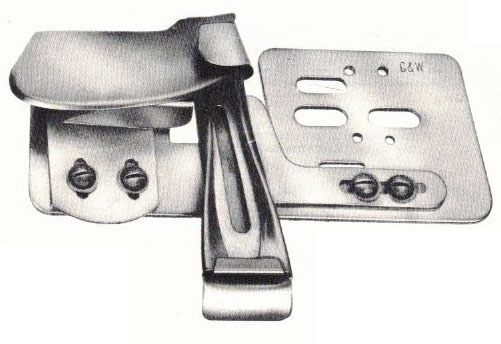 button stay folder
button stay folder
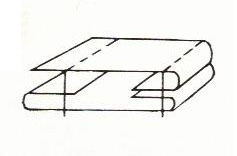 button
stay cross section
button
stay cross section
Any folders ordered with machine were listed in the brochures as being supplied
at additional charge. I’m guessing that these were originally made by Singer.
Then, at some later date, perhaps after 1948, were likely made by C&W Sewing
Machine Attachments Company. C&W was the brand of attachments that Singer
eventually offered if you weren't going custom folded at your choice of
attachment makers. The C&W catalogs proudly proffered that they were distributed
worldwide by The Singer Company!
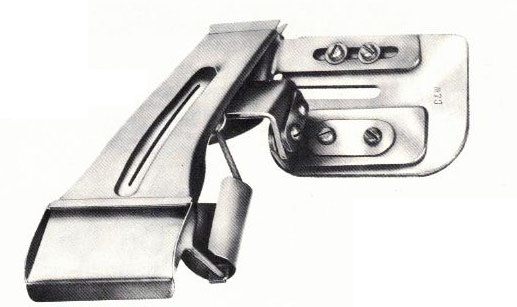 top center folder
top center folder
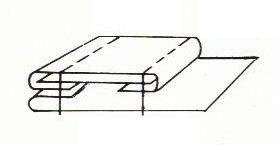 top
center folder for neck down sewing direction
top
center folder for neck down sewing direction
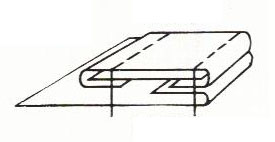 top
center folder for bottom up sewing direction
top
center folder for bottom up sewing direction
I believe C&W became, eventually, Tennessee Attachment Company.
Tennessee Attachment Company is in
business and still offer this full range of folders in each style and in each
width and with or without inserted linings and also variations including
material welt under facings and with or without cord inserted into welt while
sewing, etc. I believe that Atlanta
Attachment Co., and Linhart Sewing
Attachments (516-868-1558, 516-223-0261), among others, also all still
attachments in the USA of any type you need. Unfortunately, New York Sewing
Machine Attachment Co. does not seem to have an active website when I last
checked.
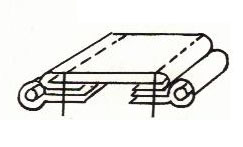 top center folder with welting inserted and optional cording
top center folder with welting inserted and optional cording
Machine Mounting to Table Top
All 147- class machines and the 152-1 and 152-11 machines came with a "bench
stand" with the machine head as the standard setup. This allowed setting the
machine base on the table top. A cast iron pan (with a drain hole) was affixed
directly to the table top. The machine sat on this and a wooden work surface
with hinged sides was installed around the machine work plate. To me this was
perhaps the least desirable mounting although it has a classic, perhaps, 1800's
look to it.
You could order two additional types of mounting at additional cost. The "semi-submerged" and the
"fully-submerged". The 152-1 was set semi-submerged on a wooden plank, similar
to what you see with many Union Special and Wilcox & Gibbs machines. The 152-11
was set upon a formed and cast semi-submerged base. The 152-1 was set fully
submerged also on a wooden plank, also similar to what you see with many Union
Special and Wilcox & Gibbs machines. The 152-11 was set upon a formed and cast
fully submerged base.
The 152-11 style semi-submerged had a cast steel base that sat under a machine
cutout. This had the machine closer to the table top surface. A wooden works was
placed around the part of the machine work plate that sat above the table.
Unlike the standard bench stand, the woodwork for the semi-submerged mounting
was fully rounded and smooth and was more substantial and covered a broader area
of the table top. The woodwork was hinged and as the machine was only
semi-submerged, you could instantly flip the hinged wood aside and have full
access to all adjustment screws. Hard to find but when I could find this
arrangement I bought it!
The 152-11 style fully-submerged had a cast steel base that sat deep so that the
machine work plate was flush with the table top surface. No woodwork needed and
the work surface was the table surface. This is nice especially for fast runs,
but the machine had to come up out of the cutout for adjustments. Not my
favorite arrangement for a service person, unless the front of the table top was
made hinged and swung out of the way. I've not seen this hinged top on these
Singer 152- class machines.
Brochure from February 1954




Brochure from May 1937



